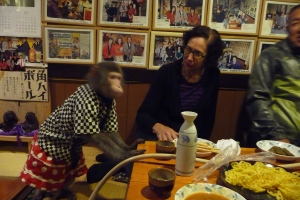My book, On The Other Guy’s Dime, is available in paper and e-book formats from Amazon, Barnes & Noble, and Apple. Read about our adventures on Facebook and follow me on Twitter: Follow @otherguysdime
Search Box
-
Join 81 other subscribers
Recent Radio Interviews, TV Shows, and Book Signings
• March 12, 2011, Rudy Maxa's Travel World, KFWB radio, Los Angeles, CA
• March 12, 2011. Peter Greenberg Worldwide,
• March 8, 2011, "KARE-11 Today," Channel 11, Minneapolis, MN.
• March 5, 2011. Interview on "Rudy Maxa's World" syndicated radio show.
• Feb. 25-27. Book Signing, New York Times Travel Show, Javits Center, New York
• Feb. 18, 2011, Dan Rivers Show, WKBN, Youngtown, OH. podcast at http://www.570wkbn.com/cc-common/podcast/single_podcast.html?podcast=rivers_audio.xml. Go to Feb 18th, Hour 1. My interview started 10 minutes into the show.
• Jan 23, 2011, Lizz Sommars Conversations, FM103.7, Seattle, WA, listen to the podcast at: http://www.kmtt.com/pages/3953960.php
• Dec 28, 2010, Milwaukee Midweek, Ann Deroski, WMSE, Milwaukee, WI
• Dec 28, 2010, Jean Dean Show, WVRC, West Virginia podcast at http://wrvc.podomatic.com/ then scroll down to Viewpoint, 12-28-10
• Dec 27, 2010, KMOX, St. Louis, MO
• Dec 22, 2010, AM Colorado, 1310 KFKA, Denver, CO
• Dec 11, 2010, Diane Dennis Show, KUIK, Portland, OR
• Dec 7, Here on Earth: Radio Without Borders, Wisconsin Public Radio, podcast at: http://www.wpr.org/hereonearth/archive_101207k.cfm
• Dec 2, Around the World Radio, KZSB, Santa Barbara CA
• Nov 30, 2010, WNWS, Jackson, TN
• Nov 24, 2010, KFBK, Sacramento, CA
• Nov 23, 2010, Watson & Oak, KDKB, Mesa, AZ
• Nov 23, 2010, Chet Walker Show, WHAM, Rochester, NYCategories
- Health Care (1)
- Uncategorized (11)
- Working Vacation (132)
- Air Tickets (4)
- Applying For (22)
- Benefits (43)
- Children Issues (9)
- Costs (4)
- Fears and Doubts (19)
- Food and Cooking (2)
- Health Care (2)
- Housing (9)
- How To Find (25)
- Language Issues (4)
- Making Friends (11)
- Motivation (46)
- Negotiating Terms (4)
- Overseas Visitors (3)
- Radio and TV Interviews (3)
- Spousal Issues (5)
- Taking Side Trips (26)
- Target Audience (20)
- Tax Consequences (2)
- Travel Contest (3)
- Useful Web Sites (7)
- Where To Go (6)
Reader’s Comments
-
Recent Posts
Archives
- November 2012 (1)
- October 2012 (2)
- September 2012 (2)
- August 2012 (3)
- July 2012 (2)
- June 2012 (3)
- May 2012 (3)
- April 2012 (2)
- March 2012 (2)
- February 2012 (4)
- January 2012 (3)
- December 2011 (2)
- November 2011 (3)
- October 2011 (2)
- September 2011 (3)
- August 2011 (3)
- July 2011 (2)
- June 2011 (4)
- May 2011 (4)
- April 2011 (2)
- March 2011 (3)
- February 2011 (4)
- January 2011 (5)
- December 2010 (6)
- November 2010 (5)
- October 2010 (4)
- September 2010 (7)
- August 2010 (8)
- July 2010 (7)
- June 2010 (10)
- May 2010 (10)
- April 2010 (11)
- March 2010 (5)
Blogroll
- A Portal for Information and Listings for Volunteer Work and Travel
- Adventure Travel Blogs: Living and Working Overseas
- An Interesting Travel Book You Might Want To Check Out: “How To Travel For Free (Or Pretty Damn Near It!)”
- Briefcases to Backpacks: Travel Advice for Career Breaks and Sabbaticals
- Escape Artist — Live Abroad, Thrive Abroad. Everything you need to know about living and working abroad.
- Go Nomad Short Term Vacation Work Abroad: An Overview of Short-Term Working Vacations
- International Job Opportunities A Search Engine for Overseas Work, Study, and Living
- Nerdy Nomad Stories of a world traveler who is able to fund his life of wandering through earnings from the Internet.
- One Family, One Year, Many Places, No Regrets A blog about a family–Mom, Dad, and two children, ages 8 and 12, who head out to see the world for a year.
- Otts World: Travel and Life Experiences of a Corporate American Runaway
- The Complete Guide To Volunteer Tourism
- The Longest Way Home A travel journal about a 33 year old guy who sold everything to go traveling around the world in hope of finding a place called home.
- The Professional Hobo The story of Nora Dunn, traveling through eight countries and three continents by working in trade for accommodation.
- The Working Nomad: Work Less, Travel More
- Transitions Abroad Website: Work, Study, Living, Working Overseas.
- Travel-O-Cafe Informal ideas for traveling on a shoestring.
- Wandering Trader's Travels : An all-inclusive travel blog with great travel articles, helpful how-to tips, and superb photographs
Top Rated
OnTop Button












